

Welcome to the whisky section for dummies. For the expert section, click here.
Whisky or whiskey?
The spirit made of malted barley or grain in Scotland is spelled Whisky. Whiskey is for the product made of malted barley, or other cereals, in Ireland and in the USA. Scotch whisky is whisky produced exclusively in Scotland and it is considered as the most complex whisky in the world.
The origins of the whisky
The term whisky derives from the gaelic name "Uisge Beatha" meaning "water of life", a direct translation form the Latin "aqua vitae". Whisky came originally form Ireland or Scotland, but no one can definitely say which country was first. The first scottish mention of whisky dates from 1494.
How whisky is made?
Foreword: the process of making whisky form barley or cereal is different. I will focus on the fabrication of malt whisky or single malt whisky, also know as pot-still whisky.
 |
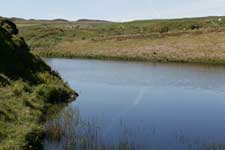 |
| Malted barley. | Water (kilbride dam, the source of Laphroaig). |
Malting
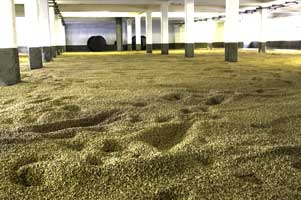 |
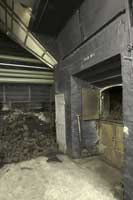 |
| Floor Malting at the Laphroaig distillery. | and its kiln with the stack of peat. |
Once the barley has been harvested (in Scotland, England or outside UK), it will be steeped for 1-2 weeks in water. When the stem start to grow, the growth must be stopped and set in on stone floors (floor maltings) where the grain are scattered before being removed to the kiln. The kilns are a kind of chimney (with a pagoda shaped roof on most of the distilleries. The barely is then dried over the peat and coke fire. During this step, the barley gains some flavours (phenols) from the peat smoke that will persist throughout the process. The barley can now be called malt.
Few distilleries (Highland Park, Springbank, Balvenie, Lahphroaig, Bowmore and Kilchoman) have floor maltings in activity and malted barley is mainly produced by Maltings like in Port Ellen or Glen Ord. Also, peat is nowdays in lower quantity than in the past and some distillieries don't use peated barley at all (e.g., Glengoyne).
Brewing
Brewing allows the conversion of the starch to sugar, which will be then converted into alcohol by the yeast.
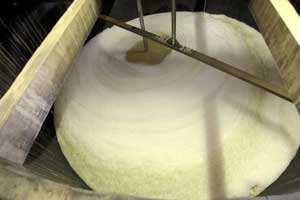 |
| The wash is almost ready. In most of the distilleries, like here in Ardbeg, the washbacks are still made of wood, usually oregon pine. |
The malt is crushed in the mill and the crushed malt will be mixed with hot water in a large vessel called the mash tun.This process is called mashing and durign this process, the starch in the malt is converted to sugar. The efficiency of the process will determine the yield of alcohol.
The sugar solution that is obtained, the wort, is then poured in the washback, a large vessel made usually of wood. What is left in the mash tun, the spent grain, is called the draff and it is used to feed the cattle.
In the large washbacks, yeast is added to the wort and by a chemical reaction called fermentation, the sugar will be transformed in alcohol. After the fermentation, the wort is called wash and its alcohol content is about 7% ABV (alcohol by volume).
Distilling
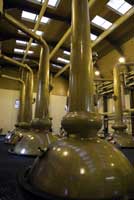 |
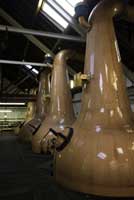 |
| The sills might have different shapes, tall like in Glenmorangie (left) | Or more onion shaped like in Benriach (right). |
During the distillation, the alcohol contained in the wash will be evaporated for being concentrated (distilled).Firstly, a copper still called Wash still, will be charged with the wash and then the distillate will be charged in a second still, the spirit still. The spirit coming out of the spirit still is then called new make, new-make spirit or clear(ic). The distillate coming out of the wash still is called low wines and it is charged in the spirit still. The first flow of spirit from the spirit still is known as the foreshot, rich in oil and undesirable residues. After the foreshots comes the real whisky also know as the heart of the run or middle-cut. As distillation goes on, whisky looses its strength and then % of alcohol goes too low, the feints, which is distilled again in the same still with the low wines coming from the wash still.
Maturation
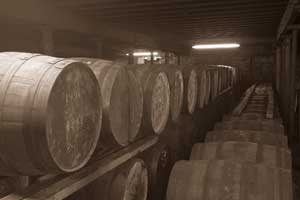 |
| Whisky is matured in oak casks in a warehouse, like in Bruichladdich. |
The new make comes at a strength of about 70% and it is reduced with distilled or spring water to a strength of about 63.5%. Then the spirit has to be matured in oak casks having previously stored American bourbon or sherry for at least 3 years in Scotland in order to be called Scotch Whisky. During the maturation, the spirit will be in contact with the wood of the casks and chemical reactions will occur and thus impair flavours to the final whisky, like vanilla flavours. Maturation takes normally around 10-16 years for a single malt.
Unless you have a bottle of cask strength single malt, the whisky is then further reduced to abou 43-40%. By law, the minimal strength has to be 40% to be called whisky. If not, it is a liqueur. Then, open your bottle, pour some liquid in your glass and enjoy your dram!
Slainthe!
NB: A single malt whisky is the whisky produced from one distillery using only barley (e.g., the Glenlivet, Glen Grant, Glenromangie). Mixing single malts from different distilleries together will give a vatted whisky.
When grain whiskies are mixed with single malt, this is called a blended whisky (e.g., Chivas, Whyte and Mackay, Jonnie Walker, J&B).